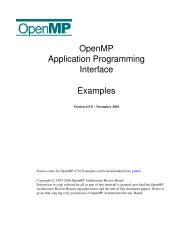D2 3 Computing e-Infrastructure cost calculations and business _models_vam1-final
D2 3 Computing e-Infrastructure cost calculations and business _models_vam1-final
D2 3 Computing e-Infrastructure cost calculations and business _models_vam1-final
Create successful ePaper yourself
Turn your PDF publications into a flip-book with our unique Google optimized e-Paper software.
e-‐FISCAL: www.efiscal.eu <br />
EC Contract Number: 283449 <br />
Model 2: Matchmaker <br />
In the ‘Matchmaker’ model, the resource allocation is managed by the federator. The customer discusses <br />
requirements <strong>and</strong> receives a resource allocation from the federator with a resource provider. The contractual <br />
agreement is established by the federator with the customer on behalf of the resource provider but any financial <br />
transaction is h<strong>and</strong>led directly between the customer <strong>and</strong> resource provider (Figure 4). The resource provider <br />
pays the federator for establishing the contractual agreement. This model is more suitable for customers who <br />
need access to many resource providers. <br />
Model 3: One Stop Shop <br />
Figure 4: Matchmaker Broker Model<br />
The ‘One Stop Shop’ model fully relies on the federator to h<strong>and</strong>le the service publication, matchmaking, contract <br />
<strong>and</strong> agreement negotiation, as well as financial transactions (Figure 5). The resource provider receives payment <br />
for the resources used by the consumer through the federator. Reliance on such a service reduces organisation <br />
overhead on both customers <strong>and</strong> resource providers by offering them a single point-‐of-‐contact to many <br />
independent counter-‐parts. <br />
Figure 5: One Stop Shop Broker Model<br />
2.6 Commercial Clouds <strong>and</strong> Pricing Models<br />
In the IT world, cloud computing not only offers the opportunity for a wide range of products <strong>and</strong> services but a <br />
number of different <strong>business</strong> <strong>models</strong> that can be offered. Based on the product or services various pricing <strong>models</strong> <br />
are applied. With cloud computing, three st<strong>and</strong>ard service categories emerged: <strong>Infrastructure</strong> as a Service (IaaS), <br />
Platform as a Service (PaaS) <strong>and</strong> Software as a Service (SaaS). A few examples of some <strong>business</strong> <strong>models</strong> in cloud <br />
computing has been the industry st<strong>and</strong>ard Amazon Web Services offering IaaS, basically selling its extra <br />
computing capacity as a service (e.g. computing power, storage). Over the years, this has grown in complexity in <br />
terms of both services <strong>and</strong> pricing <strong>models</strong>. Dropbox provides an online storage facility for more daily users, which <br />
then applies a Freemium based model (i.e. 2 GB storage free, +X is paid). <br />
e-‐FISCAL : Financial Study for Sustainable <strong>Computing</strong> e-‐<strong>Infrastructure</strong>s <br />
Deliverable <strong>D2</strong>.3 – <strong>Computing</strong> e-‐<strong>Infrastructure</strong>s <strong>cost</strong> estimation <strong>and</strong> analysis – Pricing <strong>and</strong> <br />
Business <strong>models</strong> <br />
29




